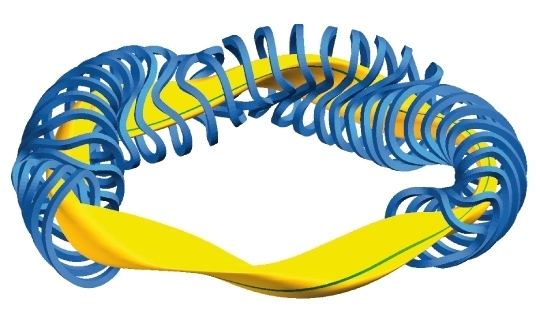 | ||
A stellarator is a device used to confine hot plasma with magnetic fields in order to sustain a controlled nuclear fusion reaction. The name refers to the possibility of harnessing the power source of the sun, a stellar object.
Contents
Invented by Lyman Spitzer of Princeton University in 1951 while on a ski trip, it is one of the earliest controlled fusion devices. Spitzer led a development effort known as Matterhorn, and the first purely experimental model, Model A, was operational in 1953. Larger models followed, but demonstrated generally poor performance, far worse than theoretical predictions. Stellarators were popular in the 1950s and 1960s, but the much better results from tokamak designs led to them falling from favor in the 1970s. The largest of the original Princeton machines, Model C, began operation in 1961 and ran until 1969 when it was converted to a tokamak.
More recently, in the 1990s, problems with the tokamak concept have led to renewed interest in the stellarator design, and a number of new devices have been built. Some important modern stellarator experiments are Wendelstein 7-X in Germany, the Helically Symmetric Experiment (HSX) in the USA, and the Large Helical Device in Japan.
How the plasma is heated
There are several ways to heat the plasma (which must be done before ignition can occur).
Configurations
Several different configurations of stellarator exist, including:
Optimization to reduce transport losses
The goal of magnetic confinement devices is to minimise energy transport across a magnetic field. Toroidal devices are relatively successful because the magnetic properties seen by the particles are averaged as they travel around the torus. The strength of the field seen by a particle, however, generally varies, so that some particles will be trapped by the mirror effect. These particles will not be able to average the magnetic properties so effectively, which will result in increased energy transport. In most stellarators, these changes in field strength are greater than in tokamaks, which is a major reason that transport in stellarators tends to be higher than in tokamaks.
University of Wisconsin electrical engineering Professor David Anderson and research assistant John Canik proved in 2007 that the Helically Symmetric eXperiment (HSX) can overcome this major barrier in plasma research. The HSX is the first stellarator to use a quasisymmetric magnetic field. The team designed and built the HSX with the prediction that quasisymmetry would reduce energy transport. As the team's latest research showed, that is exactly what it does. "This is the first demonstration that quasisymmetry works, and you can actually measure the reduction in transport that you get," says Canik.
The newer Wendelstein 7-X in Germany was designed to be close to omnigeneity (a property of the magnetic field such that the mean radial drift is zero), which is a necessary but not sufficient condition for quasisymmetry; that is, all quasisymmetric magnetic fields are omnigenous, but not all omnigenous magnetic fields are quasisymmetric.
